Cyclax
Continue to: Cyclax (1930-1945)
In 1896, Frances (Fanny) Forsythe opened a beauty salon at 58 South Molton Street, London. Like many beauty proprietresses of the time, working in a business on the border of respectability, Frances operated under an alias – Mrs. Hemming. According to one of her descendants, ladies of the time arrived at South Molton Street in horse-drawn carriages with the window blinds pulled down so that no one would recognise them.
Frances Forsythe
Frances Forsythe was born Frances Hamilton in Windsor, Berkshire in 1872. In 1895, a year before she opened her salon, she married Sydney James Forsythe. She had two children with him, Gery Hamilton Forsythe [1896-1964] and Henry Hamilton Forsythe [1900-1947]. Frances was married twice more. First, in 1912, to William Lissberger, who later changed his name to Walter Lester. The couple had two children, Robert Frances Lester [b.1913] and Margaret Hamilton Lester [b.1917]. Second, in 1932, to Robertson Braine [b.1892] shortly before her death in 1934.
In 1897, the year following the opening of her salon, Frances founded the Cyclax company. At first, its beauty products were only sold through South Molton Street but general sales began in 1902 and the company was advertising its products in newspapers and magazines by 1906.
The secret of the Perfect Complexion of noted beauties of the day is disclosed; and the Remarkable Preparations which have produced and retained these Extraordinary Results at last obtainable by the General Public, although for years they have been exclusively supplied by a Specialist solely to her private patients.
(Cyclax advertisement, 1907)
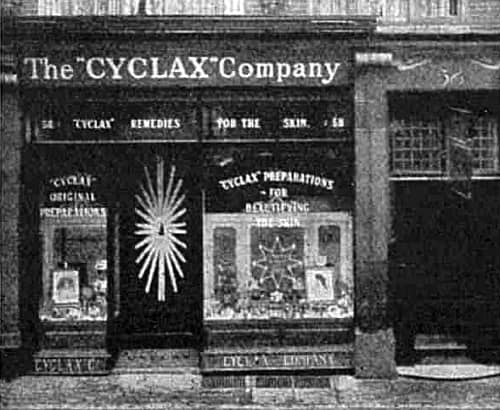
1907 Cyclax at 58 South Molton Street, London. The company was apparently named after the Cyclades Islands in Greece.
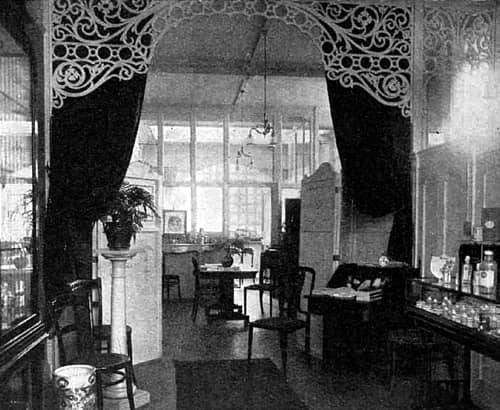
1907 Cyclax consulting room at 58 South Molton Street. A front window can be seen through the glass partition.
By 1910, the ground floor of the house in South Molton Street had been converted into three connecting salons, decorated in blue and white, with showcases in dark wood frames. By this time, salon treatments were being done by trained Cyclax consultants with Frances reduced to doing free introductory consultations, using the end apartment, on Tuesday and Thursday afternoons.
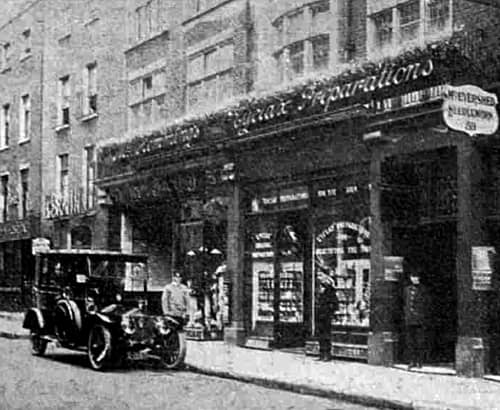
1913 Cyclax at 58 South Molton Street, London.
By 1914, there were over 40 preparations in the Cyclax range – formulated in conjunction with John Bell & Croyden, a pharmaceutical firm that dated from 1798. By then, Cyclax cosmetics were being retailed in department stores such as Selfridges and the company was advertising in trade journals to develop new outlets in chemist shops across the country.

1914 Cyclax trade advertisement.
By 1914, Cyclax had also expanded overseas so its products became available in Australia, New Zealand, South Africa and other parts of the British Empire and by the following year they were also being sold through the Wanamaker department store in the United States.

1914 Cyclax products available wholesale from Rocke, Thompsitt & Co. (Australia), Lennon Ltd. (South Africa) and New Zealand Drug Co. Ltd. (New Zealand).
In 1922, Cyclax opened a second London salon at 13 & 14 New Bond Street, possibly in response to Elizabeth Arden setting up a Salon D’Oro at 25 Old Bond Street in 1921. Arden would become a major competitor for Cyclax both in Britain and abroad. The Bond Street salon did not take and appears to have been closed by 1927, the year Cyclax opened another salon at 103 Bold Street, Liverpool. This also closed soon after it opened. Thereafter, 58 South Molton Street remained as the only stand-alone salon that Cyclax operated until one was opened in New York in 1936.
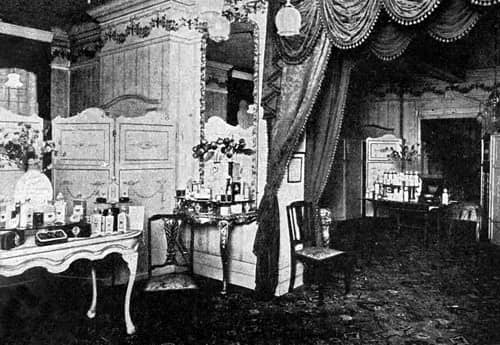
Above: 1926 Cyclax salon at South Molton Street.
Natural beauty
Early Cyclax brochures were titled ‘The cultivation and preservation of natural beauty’ and, broadly speaking, this phrase identifies the general aim of the company. Beauty was something to be developed and preserved and this included looking after your general health. Good looks could be spoilt by ‘indigestion, want of air and exercise, and neglect of that cardinal rule, cleanliness’. Consequently, early Cyclax brochures included exercises to improve general health:
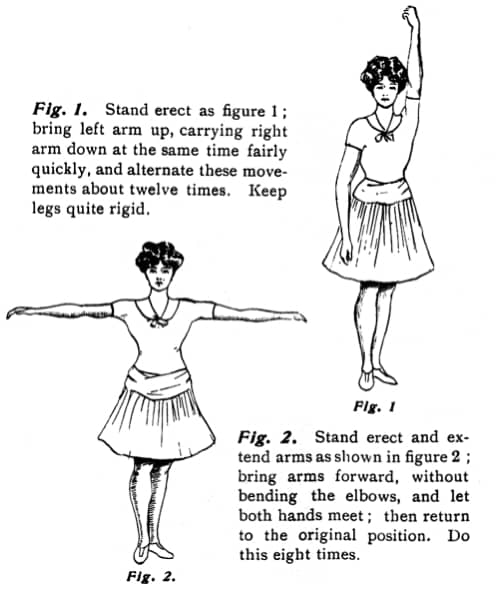
Two examples of exercises suggested by Cyclax (Modified from The Cyclax Company, 1908, p. 19)
Dietary suggestions:
Salted fish and meat are to be recommended strongly, as the value of salt in the chemistry of nature is so much neglected. … Luncheons should be light and nourishing, and nothing should be partaken of which produce flushings or heat of the face, as these are immediate danger signals announcing that the foods taken are disagreeing with the system. Tea should be taken sparingly and always freshly made. Dinners should never be too elaborate, made dishes should not be taken, and ice-puddings, ices, and black coffee should be avoided.
(The Cyclax Company, 1908, pp. 13-14)
And information on general cleanliness such as daily baths, washing hair every two weeks, and regular teeth cleansing, practices that were not firmly entrenched at the end of the nineteenth century.
The Cyclax range contained a number of products to help women with their ablutions: Cyclax Shampoo Wash, Cyclax Mouth Wash, Cyclax Sponge Washing Powder, Cyclax Bath Crystals, Cyclax Savopads, and Savon Cyclax Sarfin. The company also sold two products to help soften hard water: Cyclax Water Softener and Cyclax Oatmeal Preparation.
Also see the company booklet: The cultivation and preservation of natural beauty (1912)
Skin-care
In addition to maintaining good general health, achieving and preserving ‘natural beauty’, required that the skin be ‘fed and braced up daily, and kept free from acidity and all impurities’.
Lines on the face were a sure sign of problems. Cyclax thought these were be due to a decline in the facial muscles, caused by a lack of ‘proper nourishment and attention’. Cyclax counseled against using strong astringents or electricity to tighten these muscles, preferring instead to build them up with ‘skin foods’ combined with physical therapies such as massage and strapping. Its skin-care routine was therefore broadly in line with other Beauty Culturists of the time such as Eleanor Adair, Mrs. Pomeroy, and Marie Earle.
See also: Eleanor Adair, Mrs. Pomeroy and Marie Earle
Skin foods
Like other preparations of its type, Cyclax Skin Food was said to reduce lines and wrinkles by building up the underlying flesh. In addition to being a ‘skin food’, the company employed it as a cleanser in some of its skin-care routines and it was also credited with skin lightening and ’bracing’ properties. When added to the claim that would ‘keep indefinitely in any climate’ this suggests it may have been a modified mineral cold cream containing a mild bleach, an astringent and possibly lanolin.
Skin Food: “[I]t feeds the tissues, and plumps them up; it cleanses the pores of all impurities and foreign matter, and whitens the skin, while it builds up the flesh so that lines and wrinkles disappear, hollows cease to exist, and the unnatural depressions so often observable regain their proper form, and are no longer visible.”
In 1915, the company introduced three new skin foods: Special E Skin Food, for relaxed skin and droopy tissue; Special O Skin Food, for dry skin and Special Baby Skin Food for sensitive skin. The Special E Skin Food was more bracing so probably contained higher levels of astringents. The company later added Cyclax Thick Skin Food for undernourished skins after which the Special O Skin Food was recommended for both normal and dry skin types.
Special Baby Skin Food: “For the youthful or abnormally sensitive skin, and to prepare the way to the richer foods for neglected skins that are unaccustomed to treatment.”
Special O Skin Food: “A toning food, suitable for the majority of skins.”
Special E Skin Food: “A heavy feeding cream containing astringent oils, used only for building up relaxed chins and throats.”
Thick Skin Food: “A flesh-building cream for relaxed or undernourished skins.”
See also: Skin Foods
Cyclax does not appear to have supplement these skin foods with a muscle oil, a commonly available prepration also used to reduce lines and wrinkles by ‘feeding’ the underlying muscles of the skin. In 1914, the company introduced its Cyclax Muscle Restorer but this appears to have been another astringent not a muscle oil.
See also: Muscle Oils
Massage
Cyclax Skin Food was to be applied with appropriate massage movements. The massage method recommended by Cyclax used a combination of gentle patting along with broad but light massage strokes. Delicate skin, such as that around the eyes was tapped lightly to avoid stretching the skin but more robust areas, such as the forehead were stroked using the tips of the fingers.

Some massage movements suggested by Cyclax (Modified from The Cyclax Company, 1908, p. 45)
Cyclax did not advocate stronger muscle-strapping treatments either by hand or with an electrical massager, considering ‘vibrations and heavy massage’ artificial methods that were bound to produce ‘artificial results’.
See also: Massage, Wrinkles and Double Chins
Gentle patting or tapping movements were often accomplished with a patter. However, I have found no concrete evidence that Cyclax used or sold a patter, preferring instead to use the tips of the fingers.
It should be noted, that in working the “Cyclax” Skin food into the skin of the cheeks it should be performed by a rotary movement with one finger, preferably with the third finger of the right hand, as this has the lightest touch.
(The Cyclax Company, 1912, p. 50)
See also: Patters
Straps and bandages
Cyclax sold three devices to ‘brace’ the face and throat, the Cyclax Chip Strap, Cyclax Throat Bandage and Cyclax Forehead Strap. Like those those available from her contemporaries they were used to improve facial contours and eliminate lines and wrinkles as well as being an essential part of any treatment for double chins.

1915 Cyclax Chip Strap, Throat Bandage and Forehead Strap.
Chip Strap: “[Q]uickly and permanently banishes double chin, eliminates lines around the mouth, rejuvenates sagging and flabby tissues.”
Throat Bandage: “Indispensable in the treatment of relaxed muscles, plumps up the neck and fills out ‘salt cellars’.”
Forehead Strap: “[E]liminates wrinkles from the brow, lines over the nose, and improves the texture of the skin.”
See also: Straps, Bandages and Tapes
Beauty Culturists generally combined straps with astringents. Although Cyclax was supposedly against using ‘strong astringents’ the company made wide use of them. As well as the previously mentioned Skin Foods it would appear that Cyclax Braceine, Cyclax Large Pore Lotion and Cyclax Complexion Milk also functioned as astringents. In addition, pads soaked in Cyclax Throat Lotion, another astringent, were an essential part of treatments that used Cyclax Chin Straps. The Throat Lotion was later replaced by or renamed as the Cyclax Muscle Restorer but its application under the Chin Strap remained the same.
Throat Lotion: “[F]or stimulating the glands and muscles of the throat, and it is a sure remedy for looseness under the chin. It braces up the muscles in a wonderful way, and the face gradually regains its normal contour”.
Braceine: “[K]eeps the skin in perfect health, stimulates the action, strengthens the tissues, and make the face beautifully firm and of a youthful appearance.”
See also: Skin Tonics, Astringents and Toners
Skin blemishes
Cyclax considered that skin problems like pimples, acne, blackheads and redness were due to an excess of uric acid and bile, the remedy being to cleanse and unclog the pores so that they would release these poisons from the skin. The early Cyclax obsession with uric acid extended to the production of Cyclax Anti-Rheumatic Bath Crystals which were claimed to ‘throw off the uric acid – through the pores of the skin’. Leaving aside the efficacy of the product, uric acid is now known to be associated with gout not rheumatism. In 1922, the product was repurposed as Cyclax Violet Ray Bath Salt. It was still credited with the ability to remove skin acidity but was most commonly promoted as an obesity treatment, as a way of removing ‘superfluous flesh’. It had no connection with the high-frequency, violet ray devices that were popular in the 1920s.
See aslo: High Frequency
Special Lotion
Cyclax Special Lotion which had an iconic status within the company. The product was a modified calamine lotion painted on the face with a brush that was recommended for a wide variety of skin problems including skin acidity. Cyclax recommended using it at least once or twice a week.
Special Lotion: “[A]bsolutely cures acne, eczema, roughness, redness, blackheads, and all acidity of and in the skin.”
Cyclax Special Lotion could be used as a general cure-all but Cyclax also sold preparations for specific issues such as red or shiny noses, enlarged pores and pimples:
Nesudor: “[E]ntirely removes the shiny condition of the nose.”
Nose Ointment: “[U]nequalled for the cure of any redness, from whatever cause arising, about the surface or sides of the nose.”
Large Pore Lotion: “[D]esigned to meet the need of special cases, and particularly to reduce pronounced cases of enlarged pores.”
Complexion Cachet: “[B]anish every blemish.”
Salustra Lotion: “[S]pecially prepared to swiftly cure pimples and eruptions.”
Other preparations
In keeping with late nineteenth and early twentieth-century European ideals of female beauty, the primary aim of Cyclax skin-care cosmetics was to keep the skin ‘beautifully transparent and of a most delicate whiteness’. Until the advent of the suntanning craze in the 1920s this required protecting the skin from such things as weather extremes, sun exposure and ‘flushings’. Cyclax sold a wide variety of skin-care cosmetics that covered these tasks including: Cyclax Sunburn Lotion, containing cucumber juice; Cyclax Salusta Lotion (1907); Cyclax Blended Lotion (1912), a combination of Cyclax Sunburn Lotion and Cyclax Salusta Lotion; Cyclax Morn-dew Cream, a type of vanishing cream; Cyclax Complexion Milk; Cyclax Milk of Roses; Cyclax Transforming Lotion; and Cyclax Instanta (1917).
Apart from Cyclax Morn-dew Cream, all of these preparations were lotions and that a number of them – such as Cyclax Sunburn Lotion, Cyclax Complexion Milk and Cyclax Special Lotion – had, along with Cyclax Cleansing Lotion and Cyclax Braceine Skin Tonic, the phrase ‘To be well shaken’ prominently displayed on their bottles indicating that they contained ingredients in suspension.
It should also be noted that many of these products had multiple and overlapping uses, characteristics of many Cyclax cosmetics.
Sunburn Lotion: “[P]revents the skin from becoming weather-stained, allays all irritation, corrects flushings of the face.”
Salusta Lotion: “Most effective sedative and soothing prepration. Admiral for daily use as a protection against extremes of heat and cold.”
Blended Lotion: “[F]or day use, effectively corrects flushings, sunburn, and the results of changes of temperature.”
Morn-dew Cream: “[I]imparts a most delicate whiteness to the skin of the face, neck, arm and hands, and is particularly adaptable to hot climates, as it represses the unpleasantness of perspiration.”
Complexion Milk: “[M]akes the skin smooth, eradicates lines, closes the open pores, prevents relaxation of the skin and muscles.”
Milk of Roses: “[C]ures most obstinate cases of chapped skin (either of the hands or the face).”
Transforming Lotion: “This is specially designed as a protective agent against all change of temperature and the effects of exposure of all kinds. It is, therefore, an ideal preparation for motorists, as … dust is prevented from settling in the pores, and the skin is rendered impervious to all outside deleterious influences.”
Instanta: “It beautifies and revives the skin, rendering it white, clear, and smooth.”
Some of these skin-care cosmetics could be considered forms of make-up. For example, both Cyclax Sunburn Lotion and Cyclax Blended Lotion functioned as foundations and came in a range of thicknesses and shades so that clients could choose the one best suited to their particular skin texture and colouring.
Bleaches
Given the emphasis on skin whiteness, Cyclax also included a number of specific skin bleaches in its range. As well as Cyclax Hand Bleach there was Cyclax Clenzene to remove stains caused by high collars and fur dyes, or pigmentation produced by inadvertent sun exposure.
Hand Bleach: “[R]enders the hands beautifully smooth and white, and keeps the skin exceedingly soft and elastic.”
Clenzene: “It quickly removes obstinate discolourations and whitens and improves the skin without injuring it in any way.”
Home treatment
Early Cyclax home treatments consisted of a morning and evening regime with the occasional special routine at night. The procedures had a wide application as few allowance were made for different ‘skin types’ or for specific regions of the face, except perhaps for the eyes and throat.
Home Treatments
On alternate nights use “Cyclax” Skin Food and “Cyclax” Complexion Milk in the manner described below:—
(a) “Cyclax” Skin Food:—Apply freely over the face and throat, working in the Skin Food very lightly with the third finger of the right hand gently all over the face, using a rotary movement.
(b) “Cyclax” Complexion Milk:—Sponge the face well with Complexion Milk, and allow it to remain on for a few minutes. Then dry with a soft towel except around the eye muscles, where the action of the Lotion is more beneficial if not wiped off.
(c) “Cyclax” Special Lotion:—On one night in each week use the “Cyclax” Special Lotion in the manner described in directions for the Special Treatment.
Morning Treatment
Apply Skin Food bountifully in the manner described above; allow it to soak in as long as possible, perform the facial movements … then wash in cold water, to which add one teaspoonful of Oatmeal Preparation and one teaspoonful of “Cyclax” Braceine. Use, for washing, a Turkish towelling washing-square and “Cyclax” Soap. Afterwards sponge freely with the cold water mixed with “Cyclax” Braceine and Oatmeal Preparation. Then, with Absorbent Wool, apply lightly a grain or two of “Bloom of Nature” Powder, and “Cyclax” Salustra Lotion … Wipe with a soft towel, taking care that no visible deposit is left on the face. Apply a little Skin Food to the bridge of the Nose, then dust “Cyclax” Face Powder over the whole face and polish off with Absorbent Wool.
Special Treatment. Night
Instead of using “Cyclax” Skin Food or “Complexion Milk,” on one night in each week wash well with warm water, Oatmeal Preparation, and “Cyclax” Soap. Afterwards paint the face with “Cyclax” Special Lotion, and allow it to dry on. When dry, paint on a second coat freely, and allow it to remain throughout the night. In the morning perform the Morning Treatment as usual.(The Cyclax Company, 1908)
There were changes in this home treatment routine through to 1930 but apart from ending the morning treatment with a foundation and face powder, the principles remained essentially the same. A morning treatment with Cyclax Skin Food followed by a good face wash with Cyclax Soap and water; an evening treatment that started with cleansing and finished with Cyclax Skin Food; and a special treatment once or twice a week with Cyclax Special Lotion.
Morning: Let Cyclax Skin Food soak deep into your pores, softening and whitening the skin and bracing up the muscles below. Then have a refreshing wash with Cyclax Soap, which is a beauty treatment in itself, and finish with a cold sponging. Your skin is now cleansed, soothed and nourished, ready for the final finish of Cyclax Blended or Sunburn Lotion and Cyclax Powder.
Evening: Clean with Cyclax Cleansing Lotion, then massage with Cyclax Skin Food. On alternate nights use Cyclax Astringent Complexion Milk to tighten the pores and smooth out wrinkles. Once or twice a week, paint your face and neck with the wonderful Cyclax Special Lotion which clears away all impurities and makes you skin shades lighter in tone.(Cyclax advertisement, 1929)
Variations in this routine mainly concerned the type of skin food employed, Special E Skin food for ‘relaxed’ skins, Special O Skin Food for normal and dry skins, Baby Skin Food for sensitive skins and Thick Skin Food for skins that were ‘undernourished’.
Eye cosmetics
Cyclax sold a small number of preparations specifically formulated for the eye area: an eyewash and two cosmetics to darken and beautify eyebrows and eyelashes. Like the rest of the face, the delicate skin around the eyes was treated with an appropriated Cyclax Skin Food.
Cyclax Lustrozene was used to darken eyelashes and eyebrows. It came in two forms, a liquid and a paste. It might be thought that the paste was a cream but it is more likely that it was a standard cake mascara.
Eye Lotion: “[G]ives immediate relief, and produces a most beautiful feeling of freshness and rest to the nerves of the eyes.”
Lustrozene: “[D]arkens and beautifies the eyelashes and eyebrows.” Shades: Black and Brown.
Eyebrow Pomade: “[W]hile stimulating the growth, it causes the colour to deepen by natural means and the eyebrows to become luxuriant.”
See also: Cake Mascara and Liquid and Cream Mascara
Make-up
Cyclax preached that ‘women of discrimination’ did not use make-up to hide imperfections but rather cured them with ‘proper remedies’.
It must appeal to the woman of discrimination that it is quite wrong to use “make-up” in the hope of hiding imperfections of the skin as it can only be brought into a condition of perfect health by using proper remedies. It is a grave mistake to imagine that ordinary so-called beautifying washes, rouges, etc. will conceal the ravages of time on the human face, as they merely serve to harden the expression and emphasise the lines and wrinkles.
(The Cyclax Company, 1908, p. 11)
Despite this admonition, like other beauty firms of the time, Cyclax sold face powders as well as liquid and powdered rouges. Attempts to justify these cosmetics as ‘beneficial’ saw the face powder referred to as Cyclax Antiseptic and Nourishing Face Powder early on and, although it dropped both words from the title it continued to claim that its face powders were ‘antiseptic and nourishing’ for many years.
During the 1920s, Cyclax began to place more emphasis on make-up. It is telling that it dropped ‘The cultivation and preservation of natural beauty’ as a title for company brochures after 1927 with the commonest title for its booklets then becoming ‘The art of being lovely’. ‘Natural beauty’ was replaced by ‘loveliness’ which required both skin-care cosmetics and make-up.
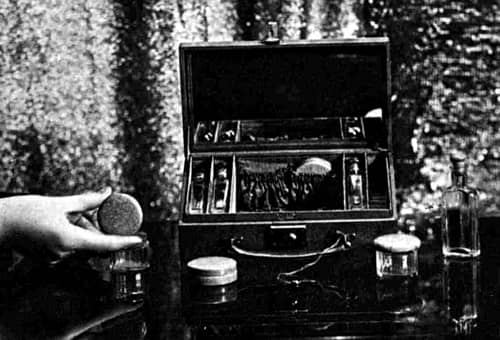
Above: 1928 Cyclax Travel Case with a range of skin-care cosmetics and make-up.
Foundations and face powders
By 1921, Cyclax Face powder came in seven shades and this remained the situation for the remainder of the decade. However, if required, the company would blend these produce a shade more suited to an individual client. The powder was described as ‘extra-ordinarily fine’ in part because one of the ingredients appears to have been pollen from an unknown flower. Cyclax recommended that its face powders be applied with a swansdown puff. All other types of puff were thought to be injurious as they forced powder into the skin which irritated or damaged the pores.
Cyclax Face Powder was applied over a finishing lotion, Cyclax Blended Lotion or Cyclax Sunburn Lotion being most commonly recommended. Both of these foundations came in a range of shades but like Cyclax face powders, available shade ranges before the 1930s are unknown to me.
Face Powder: “[P]ractically invisible, and yet at the same time imparts a most perfect surface to the skin. It is an extraordinarily fine powder, and is in every way beneficial, and guaranteed not to clog the pores. Further its action is antiseptic and it neutralises the effect of perspiration.”
Although Cyclax Blended Lotion or Cyclax Sunburn Lotion were the most commonly recommended powder foundations or finishing creams they were not the only alternatives. Women who wanted an untinted foundation could use the previously mentioned Cyclax Morn-dew Cream or Cyclax Milk of Roses. If a greater covering power was needed there was also Cyclax Foundation Cream.
Foundation Cream: “A powder cream for evening use, for covering spots, and giving a satin smooth appearance to the arms and neck.”
Rouge and lipstick
Cyclax included both liquid and powdered rouge in its range early on, with the liquid rouge being suitable for use on either the cheeks or the lips. The liquid rouge was probably made with carmine or something similar as it does not seem to have been indelible. In 1927, the company introduced Cyclax Permanent Lip Lotion in two shades, one for blondes and a second for brunettes. As this was indelible it was most likely formulated with eosin dyes.
Cyclax also sold Cyclax Labyl, a lip protectant and lip colourant. The formulation of this lip salve product is unknown to me but it may have come as a stick and appears to have been sold in a range of colours.
‘Bloom of Nature’ Powder: “[I]mparts a natural colour to the cheeks. It is quite unlike rouge or any preparation of that kind. It imitates incomparably the natural colour, and is absolutely undetectable.”
Lip Lotion: “[C]ures the most obstinate cases of cracked lips, and renders them invariably soft, natural in colour and condition, and mobile. A few drops applied to the cheeks impart a natural and beautiful colour to the skin.”
Labyl: “[A]dds colour to the lips and keeps them soft and pliant.”
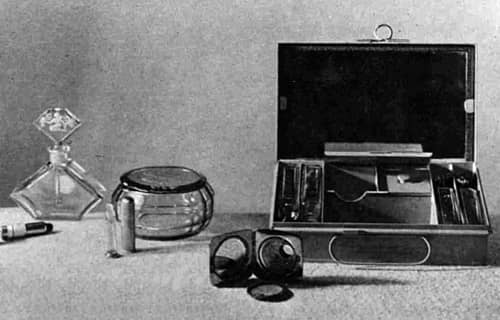
Above: 1929 Cyclax Beauty Case, Paquerette Perfume, Powder Sifter in enamel and silver, and Lipstick.
By the end of the decade, Cyclax was also selling lipsticks. I have no information on these except that they were indelibles.
Timeline
| 1896 | Frances Forsythe opens a business in 58 South Molton Street, Mayfair using the name Mrs. Frances Hemming. |
| 1897 | Cyclax Company founded. |
| 1902 | General sales commence. |
| 1903 | Cyclax trademark obtained in Great Britain and Ireland. |
| 1907 | New Products: Salusta Lotion. |
| 1909 | New Products: Clenzene. |
| 1912 | New Products: Blended Lotion, Complexion Balm; and Large Pore Lotion. |
| 1914 | Cyclax expands overseas. New Products: Muscle Restorer. |
| 1915 | Cyclax products with limited distribution in the United States. New Products: Special E Skin Food; Special O Skin Food; Baby Skin Food and Lip Salve. |
| 1917 | New Products: Instanta. |
| 1919 | Gery Forsythe returns from the U.S. to work for Cyclax. |
| 1922 | Salon opened at 13 & 14 New Bond Street, London. New Products: Violet Ray Bath Salt. |
| 1927 | Salon opened in Liverpool. New Products: Cleansing Lotion. |
| 1929 | South Molton Street salon refurbished. |
Continue to: Cyclax (1930-1945)
First Posted: 12th March 2011
Last Update: 2nd November 2020
Sources
The chemist and druggist. (1859-) London: Morgan Brothers.
The Cyclax Company. (1908). The cultivation and preservation of natural beauty [Booklet]. London: Author.
The Cyclax Company. (1912). The cultivation and preservation of natural beauty [Booklet]. London: Author.
Gunn, F. (1973). The artificial face: A history of cosmetics. London: David & Charles.
Perfumery and essential oil record. (1910-1969). London: G. Street & Co., Ltd.
Wykes-Joyce, M. (1961). Cosmetics and adornment: Ancient and contemporary usage. London: Peter Owen.
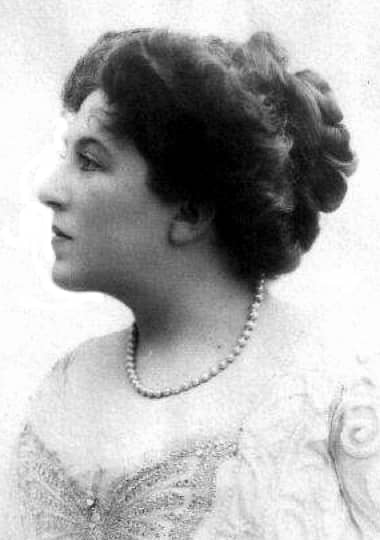
Frances (Fanny) Forsythe [1872-1934], nee Frances Hamilton, a.k.a. Mrs. Frances Hemming.
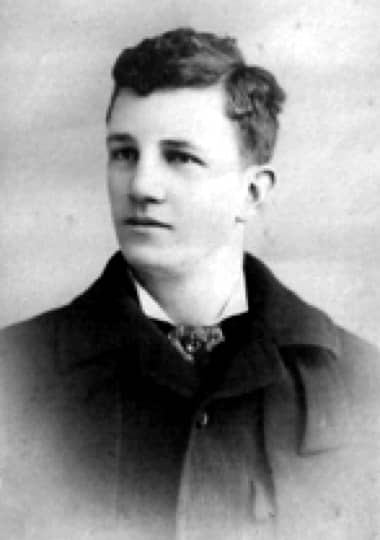
Sydney James Forsythe [b.1870] married Frances Hamilton in 1895. He was listed as a hotel manager on the birth certificate of his son Gery. Frances was listed as a widow when she married Walter Lester so I assume her marriage to Sydney Forsythe ended with his death rather than by divorce.
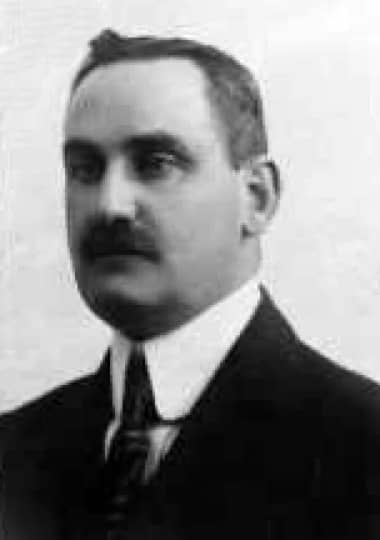
Walter Lester [1872-1930] a.k.a. William Lissberger married Frances Forsythe in 1912. Born in New York, he became a wealthy businessman with his will recording an estate of US$2,503,496. This photo was used on his 1915 passport.
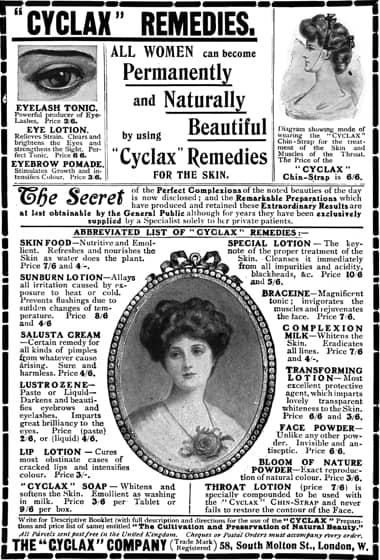
1908 Cyclax.
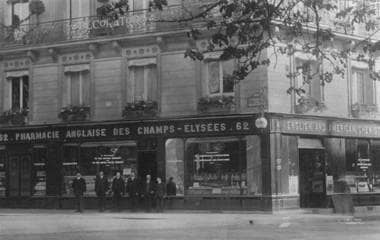
The Pharmacie Anglaise des Champs-Elysée sold Cyclax products in Paris from 1898.
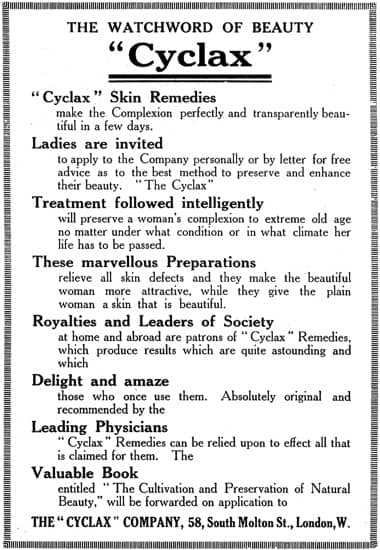
1912 Cyclax. The Watchword of Beauty.
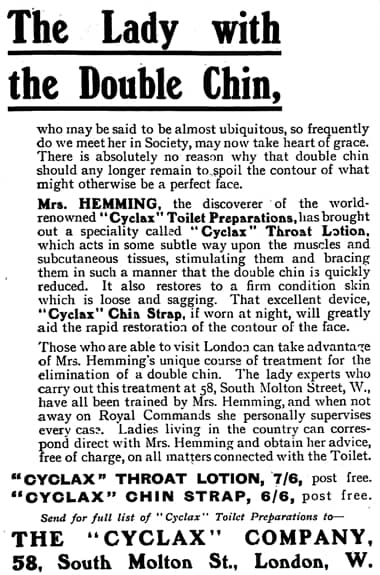
1913 Cyclax Chin Strap and Cyclax Throat Lotion.

1913 Cyclax Transforming Lotion, Cyclax Complexion Balm and Cyclax Clenzene.
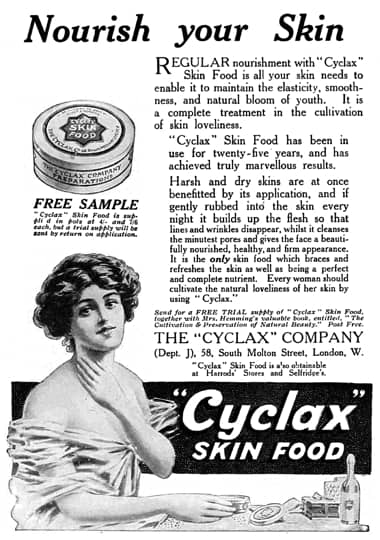
1914 Cyclax Skin Food.

1914 Cyclax Chin Strap.
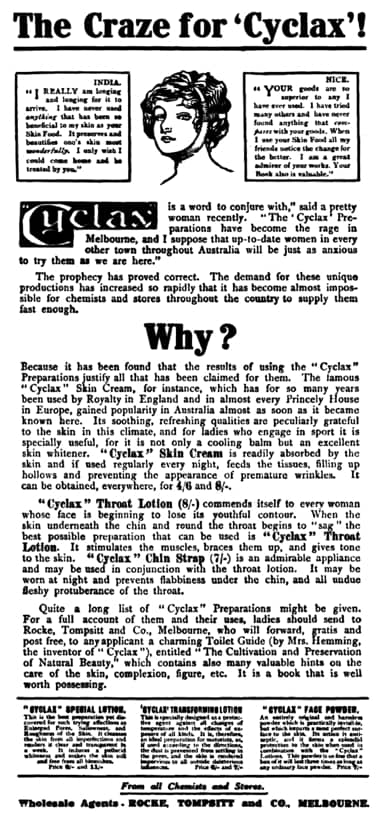
1914 Cyclax (Australia).
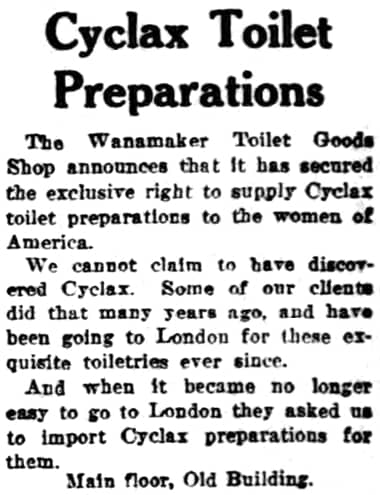
1915 Wanamaker’s, New York.
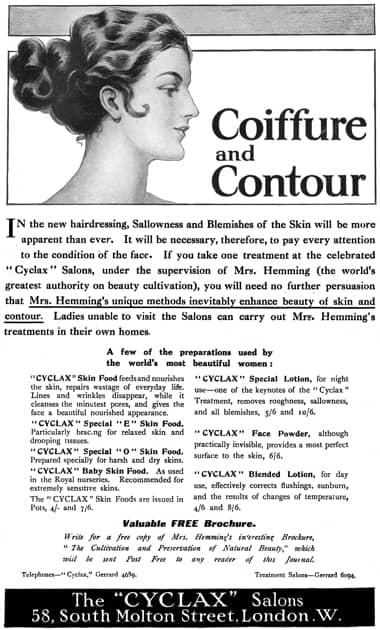
1915 Cyclax Special E Skin Food, Cyclax Special O Skin Food, Cyclax Baby Skin Food, Cyclax Special Lotion, Cyclax Face Powder and Cyclax Blended Lotion.
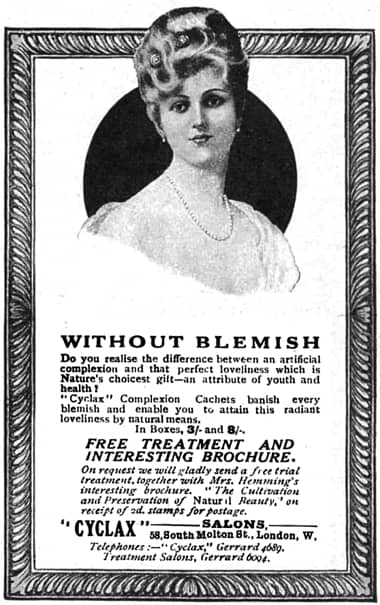
1916 Cyclax Complexion Cachet.
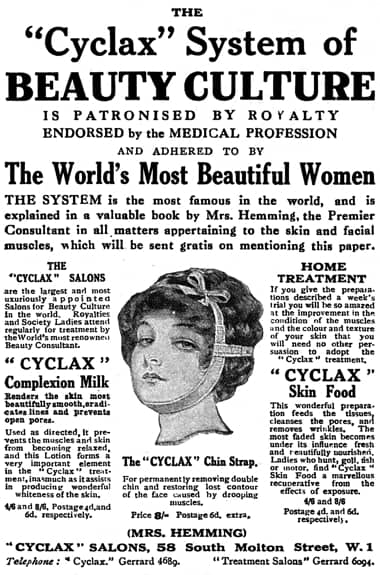
1920 Cyclax System of Beauty Culture.
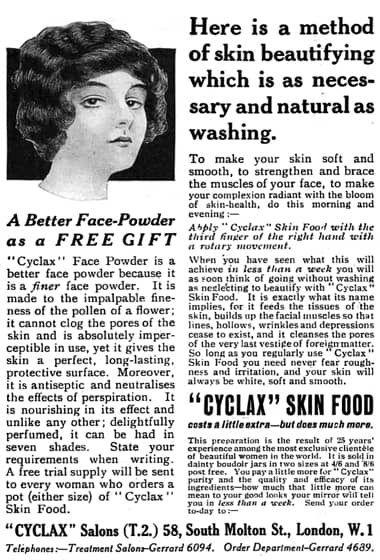
1920 Cyclax Face Powder and Cyclax Skin Food.
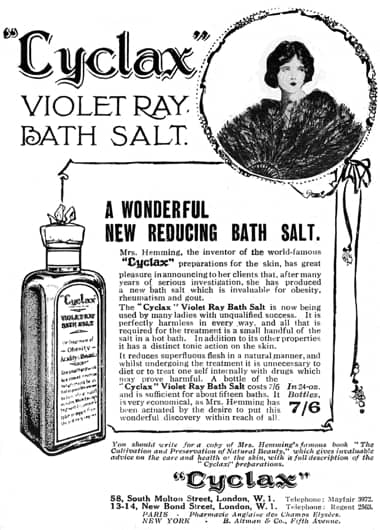
1922 Cyclax Violet Ray Bath Salt.
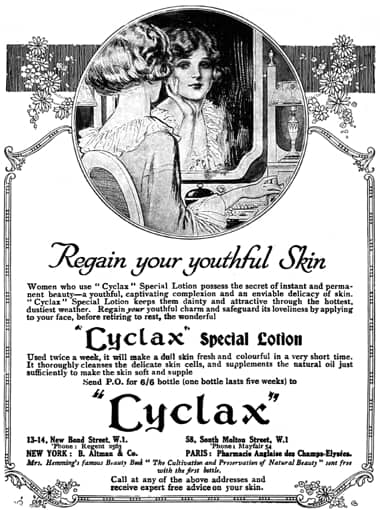
1922 Cyclax Special Lotion.
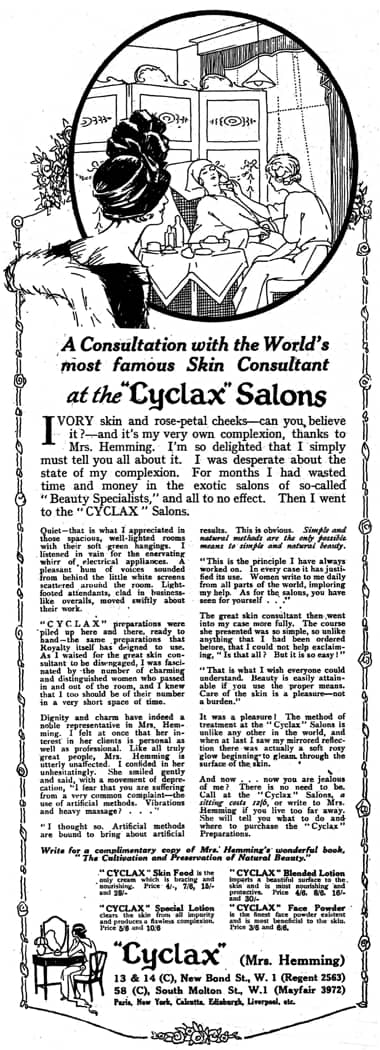
1924 Cyclax Salons.
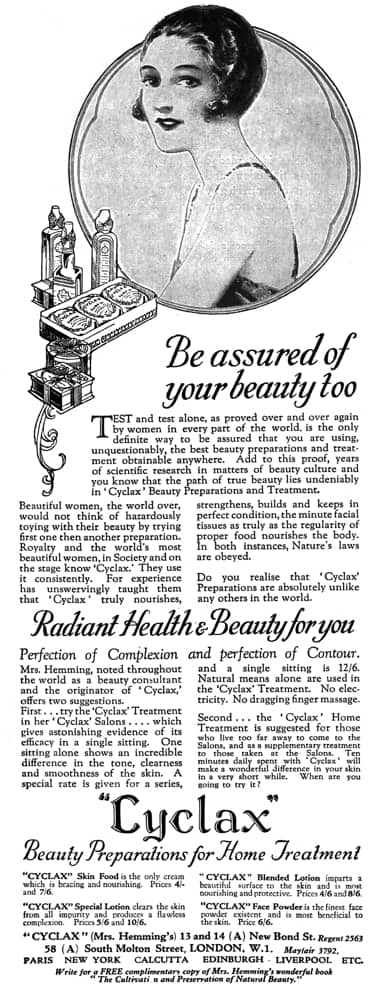
1925 Cyclax home treatment preparations.
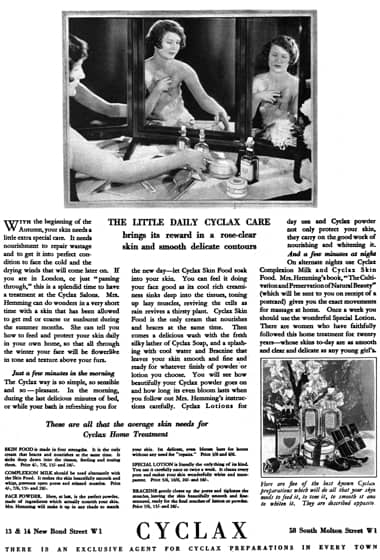
1926 Cyclax daily care.
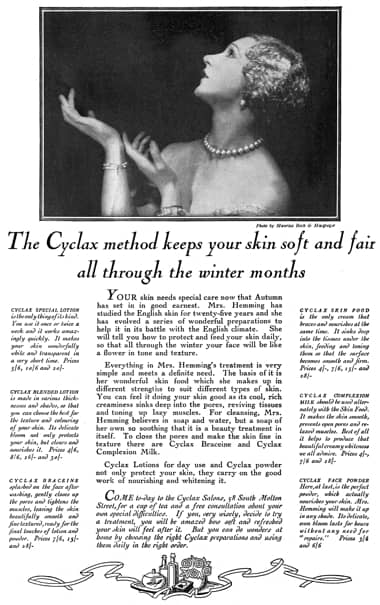
1926 Cyclax winter treatments.
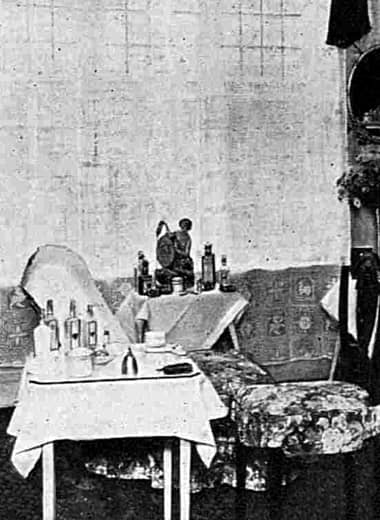
1926 Cyclax Treatment Room (London)
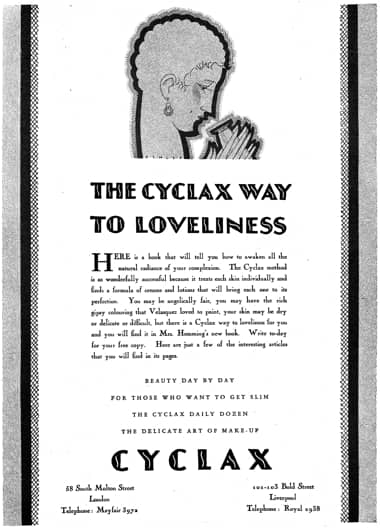
1927 The Cyclax Way to Loveliness.
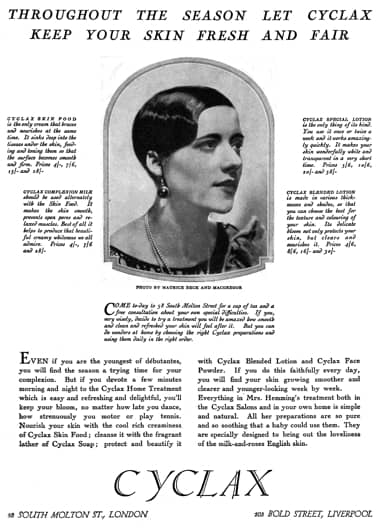
1927 Cyclax.
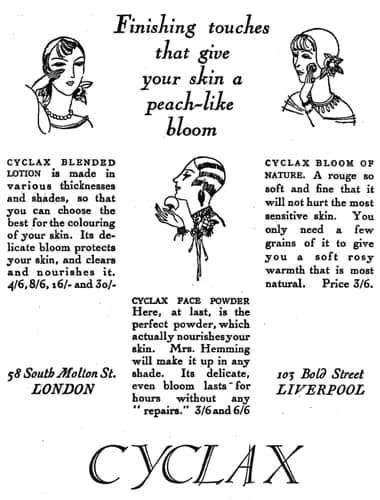
1927 Cyclax Blended Lotion, Cyclax Bloom of Nature and Cyclax Face Powder.
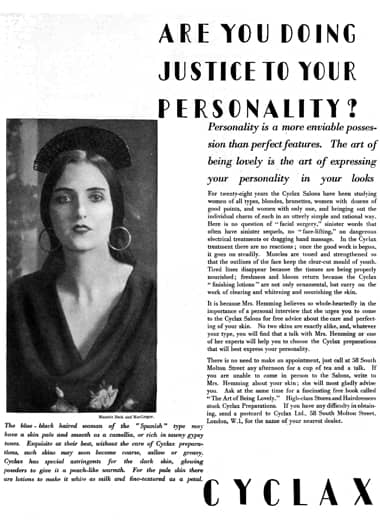
1928 Cyclax make-up by personality.
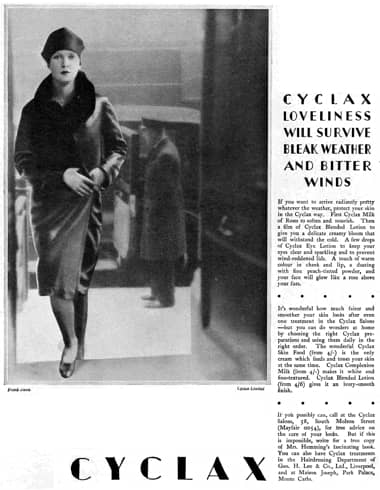
1928 Cyclax winter skin-care.
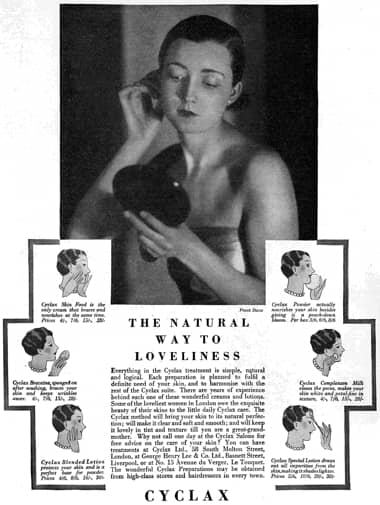
1928 Cyclax Natural Way to Loveliness.
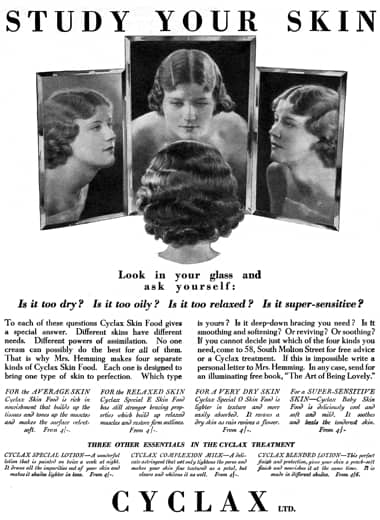
1929 Cyclax for different skin conditions.
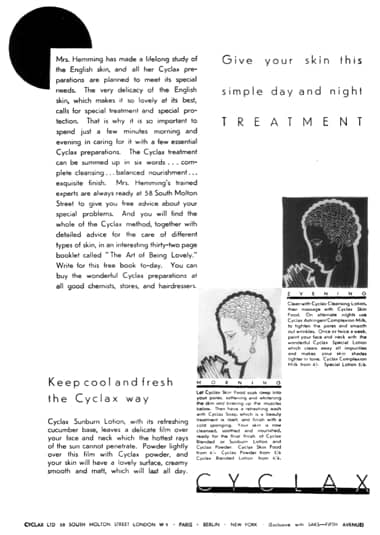
1929 Cyclax day and night treatments.
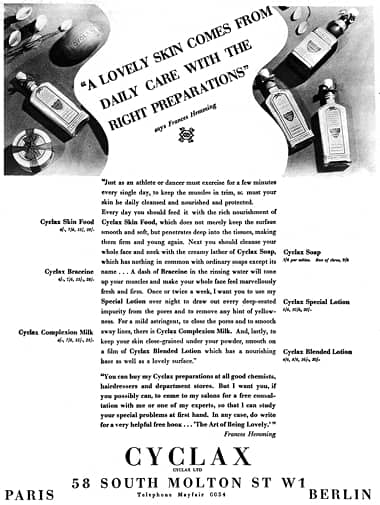
1930 Cyclax daily skin-care.
